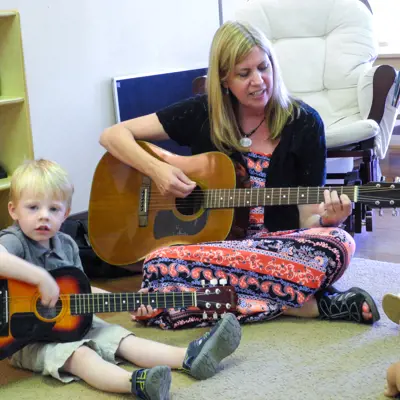
Getting to know Karen Becker
June 8, 2015
Many employees know Children's Learning Center teacher, Karen Becker, or "Ms. Karen," as the children call her. She has taken care of many of our children who have attended the center. She brings a creative energy to the classroom, incorporating music, sewing, storytelling and art.
Karen has always known she wanted to work with children. In fact, helping or teaching children runs in the family. She is one of six girls, and each of them has worked with children in some capacity: as teachers, case managers for children and families, school bus drivers and daycare owners.
Karen majored in religion/sociology in college and served as a youth minister in various churches. She is now in the process of completing her degree in early childhood at USI. She began working at the Children's Learning Center on campus nearly eight years ago, starting as a part-time administrative assistant and serving as a substitute teacher. It was always her goal to become a teacher in the center, so when a permanent teaching spot opened, she jumped at the opportunity.
Let's find out why the children and their parents love "Ms. Karen."
When and how did you decide to become a childcare specialist?
I always knew I wanted to work with children and all my sisters also work with children. Even my dad who was an engineer would go around to different schools and do demonstrations for children on how to leaf stamp quilts. My mother, if anything needed to be sewn for a school, she'd always do it. So the whole family has been involved with education and children in same way or other.
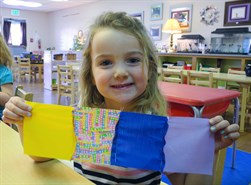 What do you enjoy most about working with the kids?
What do you enjoy most about working with the kids?
Their smiles, hugs, laughter and their complete innocence and trust. They love being here and it's a good feeling when you walk in. You can be down or sad, but there's no way you can be depressed after being around them. They just make you feel so much better. They can hug you, smile at you or just say something that lifts your spirit. They're so happy and curious.
Tell me how you learned to sew.
I grew up in a family where everybody sewed. My grandmothers always had a quilting frame up with a quilt in it. My dad was always quilting - designing and piecing quilts, and my mom was more of a seamstress. My mom was a stay-at-home mom and my dad was an industrial engineer. I have five sisters and with six kids it cost a lot of money and we couldn't afford store-bought clothes, so my mom made all of our clothes. The first pair of jeans I bought was in high school.
I remember at a young age, my grandmothers would sit down with us with [fabric] blocks and we would start sewing. The first full-sized quilt I made was when I was in eighth grade.
It was the same with my children. I have a picture of my daughter, Amy when she was about three and both of my grandmothers are sitting in chairs quilting in their quilting frame and she is standing on a bench between them quilting. It's a beautiful picture because there was 90 years difference between one of my grandmothers and Amy. She was 93 and Amy was three, and they're quilting together. My grandmothers never took out any of her stitches; they would stitch over them if they were too big, but they left all of hers in.
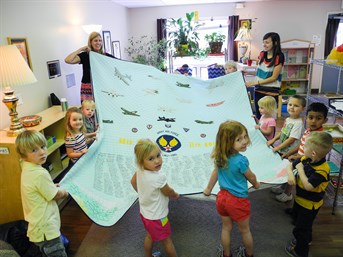 I was told you have a special quilt your father made. Can you tell me about it?
I was told you have a special quilt your father made. Can you tell me about it?
My dad, as a boy, was sick a lot and back then you were quarantined. He was quarantined a lot and his mom started trying to find things for him to do because he would get bored. So she started teaching him how to design and piece quilts. Dad was a quilter after that.
He was in World War II in the Army Air Force and he was stationed in Italy and Germany. One night he drew guard duty and the rest of his unit died in a crash that night. If dad hadn't drawn the guard duty, he would've been dead too.
Later dad designed a quilt. At the top are the airplanes dad worked on - he drew them, cut them and appliqued them on. In the middle of the quilt are all his emblems and ranks. The next part includes the names of people in his unit and, right underneath that, there's a gold box with the names in gold; those are the men who had died the night the plane crashed. At the bottom is a map of the United States and Europe and it shows his route to where he was stationed.
He made the entire thing by hand and it's the most beautiful quilt. It is very detailed and looking at his stitches you would think it was sewn by a machine, but it was all done by hand. He was so meticulous about everything he did.
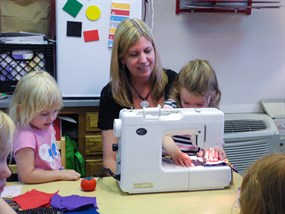 Why is it important to incorporate sewing in the classroom?
Why is it important to incorporate sewing in the classroom?
There's so much you can learn from it. I believe that children are capable and intelligent, and they can do so much more than most people allow them to or believe they can. I saw my own daughter quilting when she was three, so I knew it was possible.
Sewing builds fine motor skills. Students learn basic mathematics and cutting. It teaches them about respect and history. It teaches recycling. Instead of throwing something away we can cut it up and make something new out of it. One of the neatest things is picking a material from old clothing or something you've had around the house, it's a way of remembering.
Also they learn patience. It can be frustrating, but they learn to walk away and come back.
My dad made over 100 quilts and gave them all away. He never sold a single one. It was how we learned the art of giving.
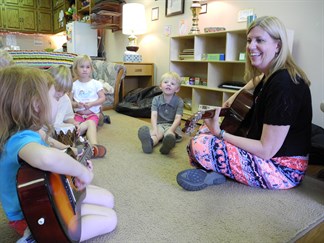 Tell me about music time with the children. How do the children react?
Tell me about music time with the children. How do the children react?
I believe music is the universal language. I think children learn better from music than any other tool. If we're talking about the planets and sing a song about it, through the song, they learn the planets.
Music is another way of lifting your spirits too. I play the guitar in the classroom just about every day. When I get out the guitar the kids' eyes get big. We have a couple of child-sized guitars. I wish I had enough for all of them. I really like the idea of them all having a guitar they can play along.
They love to sit down and play with me and sing. We make up our own songs. It's just a happy time in the room. We can sing and dance.
Tell me about going to Italy.
I went to Reggio Emilia, Italy to learn about the Reggio Emilia approach. It's an awesome way of dealing with children and with the belief that children are capable and intelligent and there are no limits for them. The things children achieve there are amazing. I was lucky enough to go about a year ago for the North American study group. I'm trying to incorporate that more in the classroom. I think sometimes we stifle the education of children because we put so many limitations on them. In the United States the concern is always about scores and meeting standards. There (Italy) it's about letting a child be a child and learn through what they're doing.
Even though there are some limitations at the Children's Learning Center, we can apply a lot of the Reggio Emilia approach here, just by believing in a child and giving them the space to try to explore and learn.
What is your best childhood memory?
As a child, I was extremely shy and standoffish and it was very hard for me to go to school (at the beginning of a new year). I remember coming home from first grade crying and begging my parents not to send me back to school. My dad would hold me in his arms and tell me it was going to be alright. I remember, many times, falling asleep in his arms and waking up in his arms. He would never lay me down; so just remembering that love and warmth.
What's your favorite movie to watch over and over again?
Benny and Joon. I love Johnny Depp. It's about innocence. It's a story about a girl who's schizophrenic and a guy who's dyslexic. But it's really about their innocence and how they view the world and find the beauty in all the chaos. It makes me laugh and it makes me cry. I have one copy I've already pretty much worn out and I have two backups.